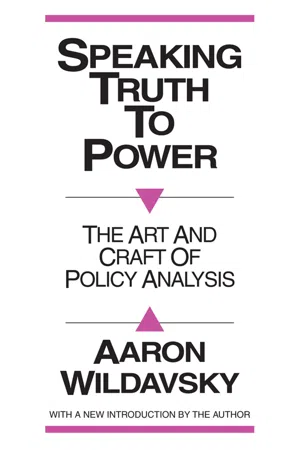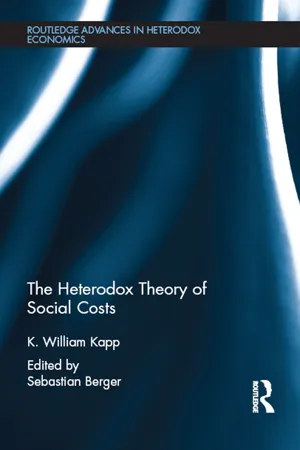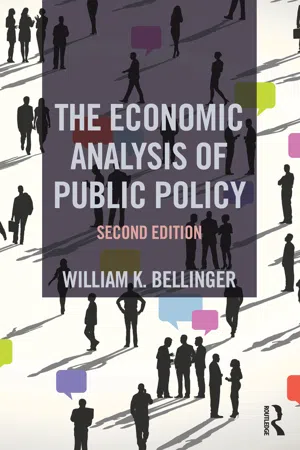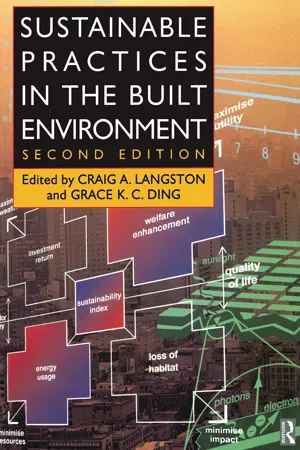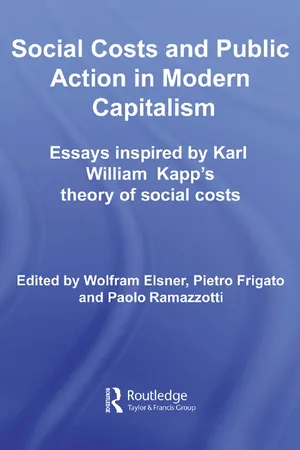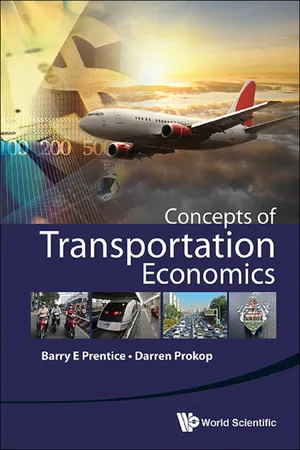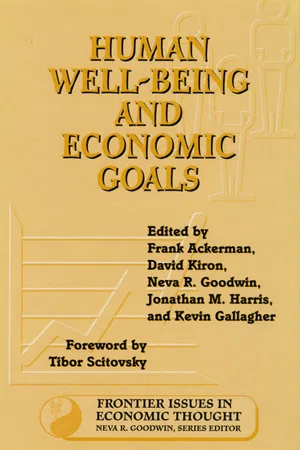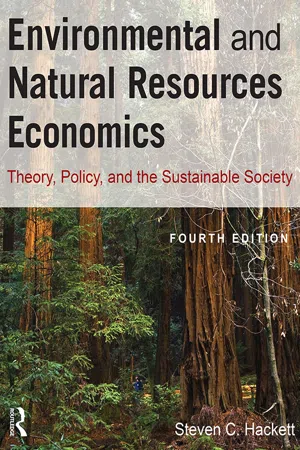Economics
Social Costs
Social costs refer to the overall costs incurred by society as a result of an economic activity, taking into account both the private costs borne by the individuals directly involved and the external costs imposed on others. These external costs can include environmental damage, health impacts, and other negative effects that are not reflected in the market price of the goods or services being produced.
Written by Perlego with AI-assistance
Related key terms
Related key terms
1 of 4
Related key terms
1 of 3
8 Key excerpts on "Social Costs"
- eBook - ePub
Speaking Truth to Power
Art and Craft of Policy Analysis
- Aaron Wildavsky(Author)
- 2017(Publication Date)
- Routledge(Publisher)
40 In general, evaluation of any activity is best accomplished by multiple, external, independent, and repetitive analysis, and the determination of the opportunity cost of resources by market interaction meets these criteria, as (multiple) individuals (independently) react, repeti-tively, to the (external) prices that result from market exchange. With this contribution, attempts by economists to preserve the range of market activity are understandable — the more alternatives the market allows individuals to collectively value, the more information results.Cost in the Public SectorIn view of its seemingly successful approach, it is tempting to embrace market price as a model for determining opportunity cost in any activity. Yet, the market is able to ignore effects (pollution, for example) that its offers do not capture. One need only recognize that it owes success to the simplicity of its goal — efficiency — to realize that transplanting the market mode of evaluation to other areas of decision-making may be unfortunate.Recognizing this difference between private and public costs may lead to challenging the correspondence of price to opportunity cost, so that, Edwin Mansfield says,The Social Costs of producing a given commodity do not always equal the private costs, which are defined as costs to the individual producer. For example, a steel plant may discharge waste products into a river located near the plant. To the plant, the cost of disposing of the wastes is simply the amount paid to pump the wastes to the river. However, if the river becomes polluted, and if its recreational uses are destroyed and the water becomes unfit for drinking, additional costs are incurred by other people. Differences of this sort between private and social cost occur frequently.41These Social Costs are frequently called externalities (having effects on individuals external to the consumer), and are not usually sold in the market, resulting in their possible neglect. Evidently, if we are to accept the results, these Social Costs must be reintegrated into market considerations.The market's difficulty in recognizing values as derived from considerations other than those based on efficiency is similarly limiting. In the private sector, as Frank Knight observes, “Price ‘tends’ to coincide with value, but the notion of value also involves a norm to which price would conform under some ideal conditions.”42 The conditions necessary for perfect operation of the market are rarely present; lack of information, subsidies, and trade restrictions, among other influences, result in prices that are not perfect reflections of value.43 - eBook - ePub
- K. William Kapp, Sebastian Berger(Authors)
- 2015(Publication Date)
- Routledge(Publisher)
36 and by means of subsidies, public investments or public enterprises, to encourage or enforce the production of social benefits. Such interference does not differ basically from the system of laws which regulates traffic or declares certain activities as unlawful if they are directed against personal or property rights of the individual. Whether these interferences with the competitive system have actually gone far enough or have gone beyond what is necessary is a question which cannot be answered in general terms but requires detailed case studies.In any event, much of our contemporary labor and social legislation has the purpose of internalizing the Social Costs of production into entrepreneurial cost accounts. It has been suggested that not only the history of economic and social legislation but of economic development in general could be written as the history of the success or failure to internalize the Social Costs of production and of the struggle to limit and resolve the conflict between individual and social interests.37 That is to say, economic history and economic policies have been shaped by precisely those aspects of economic life which economic theory in its preoccupation with formal rationality has either neglected or ignored altogether.More significant, particularly in the context of the economics of growth, is the question of the relevance of Social Costs and social returns for the acceleration of the development process. It can hardly be denied that the process of economic growth is bound up with substantial Social Costs such as the large-scale disruption of traditional processes of production and of old ways of life. Indeed, many of the classical cases of Social Costs such as the expulsion of farm workers from the land, the impairment of the health of women, children and of adult laborers, the depletion and erosion of the soil, the pollution of air and water, the obsolescence of old skills, the easy shift of the social overhead costs of labor in periods of unemployment, and the development of city slums arose first in the course of rapid economic advances in Western Europe during the Industrial Revolution. Indeed, it may be argued that the institutional arrangements which concealed the Social Costs of these early innovations and the absence of legislation which made it possible to shift these costs to third persons or to society-at-large were largely responsible for the dynamic character of economic change during the initial stages of the Industrial Revolution. Hence, any attempt by social legislation to force entrepreneurs to bear at least part of these Social Costs may have the effect of slowing down the process of economic development. In the light of this doctrine,38 it would appear that rapid economic development presupposes the systematic neglect of Social Costs, and that current attempts in many underdeveloped countries to force their productive units to internalize some of the Social Costs of production will have the effect of slowing down the rate of economic growth. Prima facie this argument seems to be irrefutable. However, closer analysis particularly of the economic effects of Social Costs and social benefits on the process of economic development reveals its limitations. In the first place, while it is true that the systematic neglect of Social Costs may make it possible to invest in projects which could not be undertaken if the Social Costs had to be internalized, it is equally true that the Social Costs once shifted have important adverse and cumulative repercussions on economic and social welfare. Thus, if in their effort to minimize the cost of current production, farmers in the underdeveloped world increase the rate of soil depletion and erosion at a more rapid rate; if expansion of industrial production in the growing cities of Asia is associated with the uncontrolled growth of slums and the widespread pollution of air and water;39 if the introduction of new industrial techniques is permitted to proceed without regard to the non-amortized value of older equipment in existing firms and the obsolescence of older skills; in short, if nothing is done to minimize these Social Costs of development, private costs are bound to rise before long if, indeed, the whole development process may not be brought to a halt by the exhaustion of the soil, the impairment of the human factor and the inevitable political polarization which such a policy of laissez-faire - eBook - ePub
- William K. Bellinger(Author)
- 2015(Publication Date)
- Routledge(Publisher)
Figure 4.8 ). If no anti-pollution policy exists, the firm will have to pay only its private costs, while the external costs faced by the fishermen need not be paid by the polluting firm.DefinitionsPrivate cost : the cost of production to the firm. This generally does not include external costs to outsiders from pollution or other effects. The usual market supply curve is based on the marginal costs of producers.External cost : the negative effect of production of a good on parties who are not involved with the production or consumption of the good. Positive externalities can be thought of as negative external costs.Social cost of production : private cost of production to the firm + external cost to others. For goods whose production or consumption leads to external harms, the good’s social cost will be higher than its private cost. However, a good that offers external benefits, such as the beekeeper’s honeybees or a beautiful building, will have a social cost that is lower than its private cost.Marginal social cost : The change in society’s total cost for a given change in output. It also equals marginal private cost plus marginal external cost. In this case, the two costs are added vertically.Figure 4.8 External costs and benefitsA current example of external and social cost relates to the issue of climate change. Economists and climate scientists contribute to an estimate of the harms of greenhouse gases known as the social cost of carbon. Greenstone et al. (2011) provided an overview of different models of climate change and reported social cost of carbon estimates ranging from $5 per ton to $35 per ton. As of 2014, the EPA’s official estimate of the social cost of carbon is $21 per ton, which was a central value in this estimated range.When external costs or benefits exist, two distinct equilibria will exist in a market. A private equilibrium occurs where demand equals the private marginal costs of production. A social equilibrium - eBook - ePub
- Craig Langston, Craig Langston(Authors)
- 2008(Publication Date)
- Routledge(Publisher)
9 Estimating Social Costs and benefits
DOI: 10.4324/9780080518251-99.1 Introduction
True Social Costs and benefits change the economic worth of society as a whole. Allocative efficiency is the key principle of cost-benefit analysis. Benefits are valued as the willingness to pay for utilities. Costs are valued as opportunity cost or the foregone return in its best alternative use. Sinden and Thampapillai (1995) use net social benefit to measure economic welfare by subtracting opportunity cost from willingness to pay. The analysis should include all changes in benefits/costs, externalities and unpriced outcomes. It should exclude sunk outcomes, fixed costs, transfer payments, double counting and international outcomes. It should consider taxes and subsidies, government charges, changes in asset values, and secondary benefits and costs. Social Costs and benefits may be valued with market prices or without market prices.9.2 Valuation with market prices
Market price is the most commonly and satisfactorily used approach to value Social Costs and benefits generated by a project. When the market is competitive, market prices are used to measure the productivity change in terms of input and output (for marginal and non-marginal changes in quantity). Sinden and Thampapillai (1995 , p. 83) state that ‘a competitive market is characterised by the small market power of participants, mobility of outputs and inputs, unrestrained opportunities for response, homogeneity of goods, and complete knowledge’.Market demand is the basis of valuing benefits and market supply is the basis for valuing costs. Under marginal change in the production of a good, the benefit of an output (or the cost of an input) is its market price times the change in quantity. In the case of a non-marginal change in production, the benefit of an output is measured by the area below the demand curve and the cost of an input is measured by the area below the supply curve. - Wolfram Elsner, Pietro Frigato, Paolo Ramazzotti(Authors)
- 2007(Publication Date)
- Routledge(Publisher)
It is definitely clear that Kapp believes that the distinctive character of Social Costs is that they should be borne by entrepreneurs, but are not. It is as if they were dodging their responsibility. If entrepreneurs have a duty to bear these costs then the ‘community at large’ has the right not to be burdened by them. In other words, entrepreneurs are also violating someone else’s rights. In a nutshell, Social Costs are the monetary side of unprotected social rights. To look at Social Costs as violated social rights has, in my opinion, far-reaching consequences and puts on a firmer ground the difference between orthodox externalities and more radical Social Costs.Indeed, all the listed items in the preceding quotation relate to some type of social rights. Also, because of this it is foolish to assume that Kapp would consider these violations less relevant and would not care about them, were the value of damages in terms of perceived welfare loss smaller than the advantage enjoyed by business firms violating those rights.I am sure he was not interested at all in Pareto-inefficient situations where some rich people suffer a significant loss as a consequence of an action yielding only a small advantage to a poor. This may be Pareto-relevant but hardly fits into the conception of Social Costs as infringements of social rights. Social Costs might very well arise in a context that is not relevant to Pareto-efficiency, even though this is not a necessary condition. Kapp’s perspective is by no means Pareto-efficiency.7He wants to draw our attention to the many types of damage that businesses impose upon non-consenting people in the real world. He looks at the whole set of uncompensated damages caused by private capitalism in its real working. It is not a coincidence that the examples he provides are so different from the neutral and anonymous cases typically considered by the more traditional literature on externalities (the rancher and the cattler, not to mention the bees and the flowers).- eBook - ePub
- Barry E Prentice, Darren Prokop(Authors)
- 2015(Publication Date)
- WSPC(Publisher)
1 This chapter discusses these external costs and public intervention in the supply of transportation. The principles of marginal cost pricing are also reviewed in the context of transportation provision.Social Costs and BenefitsAll of the costs discussed so far have been internal to the firm except for the external costs that lead to economies of scale, but even these are costs that are related to other firms within the industry or to the infrastructure upon which the industry relies. There are however, a whole set of costs of production that the firm(s) may not even be aware of. The distinction here is that the costs looked at so far have been private costs and the remaining set of costs to be examined is known as external costs. Because these costs of a firm’s production derive from external sources beyond the industry, they are referred to as externalities. An externality occurs when the actions of one or more persons or firms have an indirect effect on the well-being of another person or firm and this indirect effect is not transmitted through the price mechanism (i.e., the private market).An economist is interested in the valuation of externalities because they help one define the true Social Costs and true social benefits of production over the whole of society. Figure 8.1 presents the model of marginal Social Costs (MSCs) and benefits. The MSC are the sum of the marginal private costs (MPC) and the external costs that result from human activity. The MPC can be interpreted as a “renaming” of the supply curve. Similarly, the marginal private benefits (MPB) can be interpreted as a “renaming” of the demand curve. The marginal social benefits (MSB) are the sum of the MPB and any positive externalities.Figure 8.1.If there are neither positive, nor negative externalities the optimal position for the economy would be at A where MPC = MPB, our familiar equilibrium of supply and demand.If negative externalities are created by this activity, but no positive externalities, then the optimal equilibrium shifts to point B, where MSC = MPB. This means that the price of the activity should rise (through taxes or other means), and the quantity produced and consumed should fall. - eBook - ePub
- Frank Ackerman, David Kiron, Neva R. Goodwin, Jonathan Harris, Kevin Gallagher, Frank Ackerman, David Kiron, Neva R. Goodwin, Jonathan Harris, Kevin Gallagher(Authors)
- 2013(Publication Date)
- Island Press(Publisher)
coup de grace . . . comes when one realizes that externalities are totally pervasive. Most of the millions of acts of consumption (and production) in which we daily engage involve externalities.” [345] Almost every human activity has some nonmarket effects, positive or negative, on other people’s welfare. The benefits of participation in society are a reciprocal positive externality; thus externalities are a normal, inherent part of social life, not isolated or exceptional occurrences.In fact, the problem suggests a paraphrase of Adam Smith’s famous presentation of the “invisible hand” metaphor:Consider the implications of the neoclassical model of unrestrained, self-interested competition in a world full of actual and potential externalities. Since there are limits to what can be accomplished within the marketplace, competitive individuals will seek to maximize their gains from nonmarket transactions. Many nonmarket transactions have a zero-sum character, where one person’s gain is another’s loss; maximizing one’s gains from such transactions implies maximizing the negative externalities experienced by others. With many opportunities to create negative externalities for others, each individual will select those with maximum value, i.e., maximizing the negative externalities for the rest of society.Every individual necessarily labors to render the external costs of the society as great as he can. He generally, indeed, neither intends to promote the public misery nor knows how he is promoting it. He intends only his own gain, and he is in this, as in many other cases, led by an Invisible Foot to promote an end which was no part of his intention.... By pursuing his own interest he frequently promotes social misery more effectually than when he really intends to promote it. [348–349] - eBook - ePub
Environmental and Natural Resources Economics
Theory, Policy, and the Sustainable Society
- Steven Hackett, Sahan T. M. Dissanayake(Authors)
- 2014(Publication Date)
- Routledge(Publisher)
In principle, we can argue for government regulatory intervention in the case of pollution externalities based on efficiency alone: resources are not efficiently allocated because too much of the good is produced when externalities remain unresolved. There is also a fairness argument: unless we have a positive externality that requires subsidy, why should society have to absorb part of a firm’s costs? While economists generally accept the theory of externalities, not all agree that externalities are very large or important. Indeed, if external costs are small and insignificant, then little is lost by simply ignoring them as minor side effects of the wealth generated by markets. Measurement of damage costs must take into account the relationship between the action (e.g., pollution) and the impact (e.g., diminished human health), and between the impact and economic cost (e.g., healthcare expenditures, the value of foregone production, and the value assigned to diminished quality of life).For example, as mentioned in Chapter 1 , recent estimates by the U.S. Environmental Protection Agency (1997) indicate that the Clean Air Act of 1970 created substantial benefits in the form of avoided external costs. In particular, between 1970 and 1990 the Clean Air Act is thought to have prevented an estimated $22.2 trillion in pollution harms to human health, agriculture, and the environment in constant 1990 dollars. As will be described in detail in Chapter 6 , these benefits were substantially larger than the costs. Thus externalities can indeed be very large and are worthy of well-designed environmental regulatory policy.The National Research Council (NRC 2009) provides damage cost estimates for various types of vehicle fuels. The NRC evaluates motor vehicle damages over four life-cycle stages: (1) vehicle operation, which results in tailpipe emissions and evaporative emissions; (2) production of feedstock, including the extraction of the resource (oil for gasoline, biomass for ethanol, or fossil fuels for electricity) and its transportation to the refinery; (3) refining or conversion of the feedstock into usable fuel and its transportation to the dispenser; and (4) manufacturing and production of the vehicle. Importantly, vehicle operation accounted in most cases for less than one-third of total damages, with other components of the life cycle contributing the rest.
Index pages curate the most relevant extracts from our library of academic textbooks. They’ve been created using an in-house natural language model (NLM), each adding context and meaning to key research topics.
Explore more topic indexes
Explore more topic indexes
1 of 6
Explore more topic indexes
1 of 4
